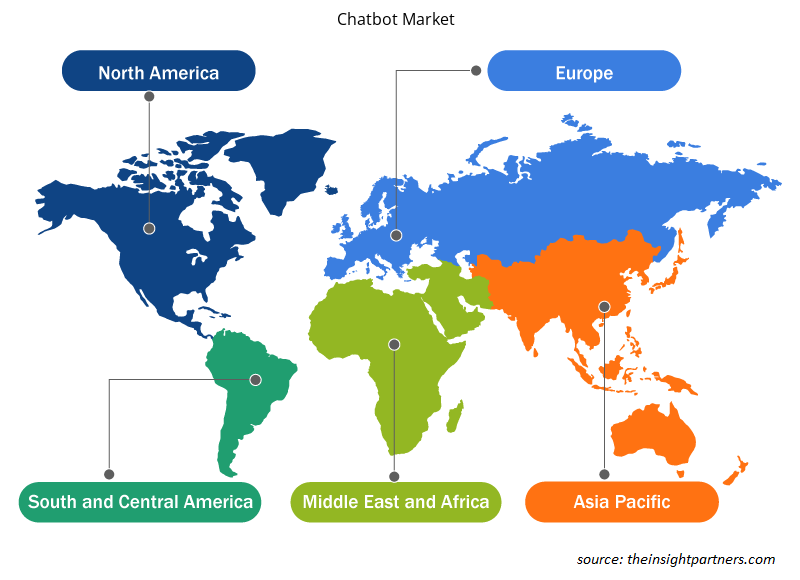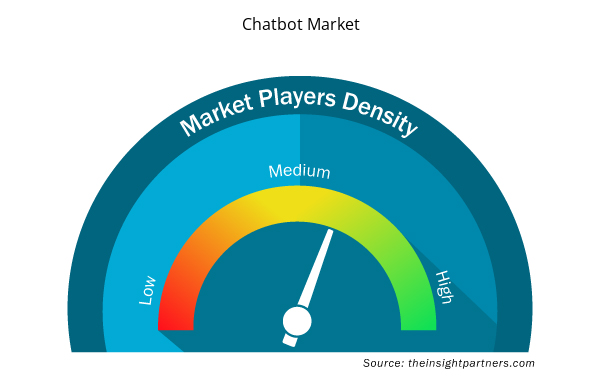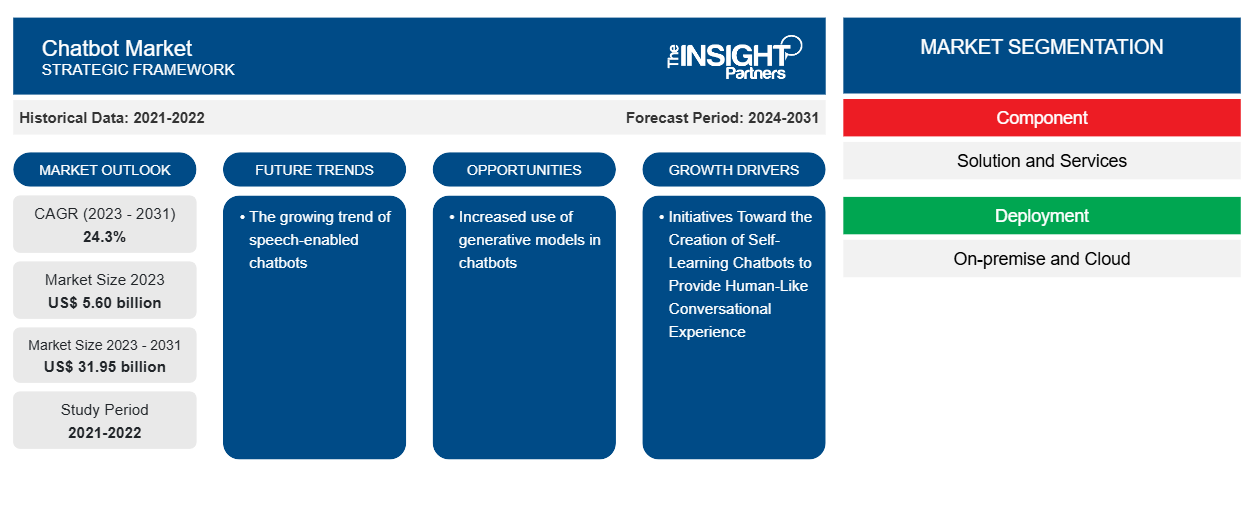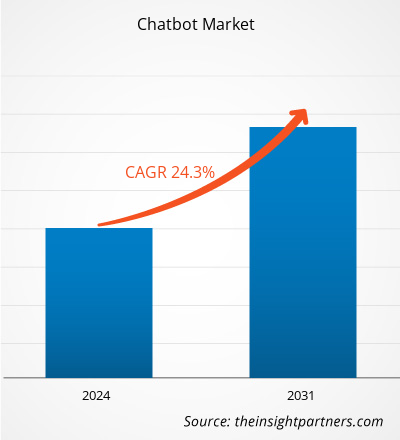Der Chatbot-Markt soll von 5,60 Milliarden US-Dollar im Jahr 2023 auf 31,95 Milliarden US-Dollar im Jahr 2031 anwachsen. Der Chatbot-Markt wird voraussichtlich zwischen 2023 und 2031 eine durchschnittliche jährliche Wachstumsrate von 24,3 % verzeichnen. Der Markt wird vor allem durch die zunehmende Dominanz von Messenger-Anwendungen und die steigende Nachfrage nach Kundenanalysen angetrieben.
Chatbot-Marktanalyse
Generative Modelle können die Fähigkeiten von Chatbots zur Verarbeitung natürlicher Sprache (NLP) verbessern, was zu einem besseren Verständnis und einer besseren Reaktion auf menschliche Sprache führt. Generative Modelle wie GPT-4 können das Verständnis von Chatbots für Benutzerpräferenzen und -gewohnheiten verbessern und so maßgeschneiderte Empfehlungen und Unterstützung ermöglichen. Aufgrund der wachsenden Beliebtheit von Messenger-Anwendungen bringt die Integration von Chatbots in Messenger eine höhere Kapitalrendite, da die Ansprache von Kunden über ihre bevorzugte Anwendung das Benutzererlebnis verbessert.
Chatbot-Marktübersicht
Der Chatbot-Markt ist in den letzten Jahren stark gewachsen. Die Notwendigkeit, rund um die Uhr Kundenservice zu bieten und die Betriebskosten durch die Delegierung von Aufgaben an Chatbots zu senken, sowie der steigende Wunsch der Kunden nach Selbstbedienungsvorgängen haben zu einer erhöhten Nachfrage beigetragen. Dies kann mit der zunehmenden Vorliebe der Menschen für Messaging-Anwendungen gegenüber sozialen Netzwerken zusammenhängen. Chatbots, die für die Integration mit Messaging-Apps entwickelt wurden, werden in Zukunft voraussichtlich ebenfalls eine hohe Marktnachfrage erfahren. Darüber hinaus erfreuen sich Chatbots wachsender Beliebtheit, da Unternehmen bestrebt sind, ihren Vertrieb und ihre Kundenbetreuung zu automatisieren. Der Einsatz von Chatbots ermöglicht es Unternehmen, zeitnahe Dienste zu geringeren Kosten bereitzustellen.
Passen Sie diesen Bericht Ihren Anforderungen an
Sie erhalten kostenlose Anpassungen an jedem Bericht, einschließlich Teilen dieses Berichts oder einer Analyse auf Länderebene, eines Excel-Datenpakets sowie tolle Angebote und Rabatte für Start-ups und Universitäten.
- Holen Sie sich die wichtigsten Markttrends aus diesem Bericht.Dieses KOSTENLOSE Beispiel umfasst eine Datenanalyse von Markttrends bis hin zu Schätzungen und Prognosen.
Treiber und Chancen auf dem Chatbot-Markt
Verstärkter Einsatz generativer Modelle in Chatbots zur Förderung des Marktes
KI hat in letzter Zeit erhebliche Entwicklungen erfahren, insbesondere im Bereich generative KI und LLMs. Auf Deep Learning basierende Modelle generieren frischen Inhalt, indem sie Muster in riesigen Datensätzen erkennen. Der Chatbot von OpenAl, ChatGPT, verwendet das Sprachmodell GPT-3.5, um menschenähnliche Prosa zu generieren, die den Kontext erkennt. Neben Text-zu-Text kann generative KI auch Bilder, Videos , 3D-Modelle, Musik und mehr konvertieren. Generative KI ermöglicht es Unternehmen, schneller und effizienter einzigartige Ideen für Produkte, Dienstleistungen und Lösungen zu entwickeln. Generative KI liefert Organisationen datengesteuertes Wissen für fundierte Entscheidungen und reduziert die mit Produktentwicklungs- und Marketingzyklen verbundenen Kosten.
Initiativen zur Entwicklung selbstlernender Chatbots für ein menschenähnliches Gesprächserlebnis
Chatbots können sich an veränderte Umgebungen anpassen und aus ihren Aktionen, Erfahrungen und Schlussfolgerungen lernen. Chatbots analysieren Daten schnell und bieten Support in vielen Sprachen, sodass Kunden die benötigten Informationen leichter finden können. Selbstlernende Bots verwenden datengesteuertes Verhalten, NLP-Technologie und überwachtes maschinelles Lernen, um eine natürlichere Kommunikation zu ermöglichen. Sie können aus ihren Fehlern lernen. Es laufen mehrere Anstrengungen zur Entwicklung selbstlernender Chatbots. Selbstlernende Chatbots bieten personalisierte und angemessene Antworten und verbessern so das Verbrauchererlebnis. Der Chatbot lernt kontinuierlich aus Benutzerinteraktionen.
Chatbot-Marktbericht – Segmentierungsanalyse
Wichtige Segmente, die zur Ableitung der Chatbot-Marktanalyse beigetragen haben, sind Komponente, Bereitstellung, Größe der Nutzungsorganisation und Endbenutzer.
- Basierend auf den Komponenten ist der Chatbot-Markt in Lösungen und Dienste segmentiert.
- Basierend auf der Bereitstellung ist der Chatbot-Markt in On-Premise und Cloud segmentiert.
- Basierend auf der Nutzung ist der Chatbot-Markt in Websites, Contact Center, soziale Medien und mobile Plattformen segmentiert.
- Basierend auf dem Endbenutzer ist der Chatbot-Markt in Bildung, Einzelhandel und E-Commerce, BFSI, Gesundheitswesen, Reisen und Tourismus und Andere segmentiert.
Chatbot-Marktanteilsanalyse nach Geografie
Der geografische Umfang des Chatbot-Marktberichts ist hauptsächlich in fünf Regionen unterteilt: Nordamerika, Asien-Pazifik, Europa, Naher Osten und Afrika sowie Südamerika/Süd- und Mittelamerika. Der Asien-Pazifik-Raum erlebt eine enorme Industrialisierung, was die Nachfrage nach Chatbots auf dem Markt erhöht. Die wachsenden Einzelhandels- und E-Commerce-Branchen in aufstrebenden Ländern wie China, Indien, Indonesien, Vietnam, Malaysia, den Philippinen und Thailand haben die hohe Nachfrage und breite Akzeptanz von Chatbots bei Händlern und E-Commerce- Firmeninhabern beschleunigt.
Regionale Einblicke zum Chatbot-Markt
Die regionalen Trends und Faktoren, die den Chatbot-Markt im Prognosezeitraum beeinflussen, wurden von den Analysten von Insight Partners ausführlich erläutert. In diesem Abschnitt werden auch Chatbot-Marktsegmente und -Geografie in Nordamerika, Europa, im asiatisch-pazifischen Raum, im Nahen Osten und Afrika sowie in Süd- und Mittelamerika erörtert.

- Holen Sie sich regionale Daten zum Chatbot-Markt
Umfang des Chatbot-Marktberichts
| Berichtsattribut | Details |
|---|---|
| Marktgröße im Jahr 2023 | 5,60 Milliarden US-Dollar |
| Marktgröße bis 2031 | 31,95 Milliarden US-Dollar |
| Globale CAGR (2023 - 2031) | 24,3 % |
| Historische Daten | 2021-2022 |
| Prognosezeitraum | 2024–2031 |
| Abgedeckte Segmente | Nach Komponente
|
| Abgedeckte Regionen und Länder | Nordamerika
|
| Marktführer und wichtige Unternehmensprofile |
|
Dichte der Chatbot-Marktteilnehmer: Die Auswirkungen auf die Geschäftsdynamik verstehen
Der Chatbot-Markt wächst rasant, angetrieben durch die steigende Nachfrage der Endnutzer aufgrund von Faktoren wie sich entwickelnden Verbraucherpräferenzen, technologischen Fortschritten und einem größeren Bewusstsein für die Vorteile des Produkts. Mit steigender Nachfrage erweitern Unternehmen ihr Angebot, entwickeln Innovationen, um die Bedürfnisse der Verbraucher zu erfüllen, und nutzen neue Trends, was das Marktwachstum weiter ankurbelt.
Die Marktteilnehmerdichte bezieht sich auf die Verteilung der Firmen oder Unternehmen, die in einem bestimmten Markt oder einer bestimmten Branche tätig sind. Sie gibt an, wie viele Wettbewerber (Marktteilnehmer) in einem bestimmten Marktraum im Verhältnis zu seiner Größe oder seinem gesamten Marktwert präsent sind.
Die wichtigsten auf dem Chatbot-Markt tätigen Unternehmen sind:
- Amazon Web Services
- Künstliche Lösungen
- Creative Virtual Pvt. GmbH.
- CX-Unternehmen
- eGain Corporation
- IBM Corporation
Haftungsausschluss : Die oben aufgeführten Unternehmen sind nicht in einer bestimmten Reihenfolge aufgeführt.

- Überblick über die wichtigsten Akteure auf dem Chatbot-Markt
Neuigkeiten und aktuelle Entwicklungen zum Chatbot-Markt
Der Chatbot-Markt wird durch die Erhebung qualitativer und quantitativer Daten nach Primär- und Sekundärforschung bewertet, die wichtige Unternehmenspublikationen, Verbandsdaten und Datenbanken umfasst. Im Folgenden finden Sie eine Liste der Entwicklungen auf dem Markt:
- Im April 2023 ging Zendesk eine Partnerschaft mit OpenAI ein, einem führenden KI-Forschungslabor mit Sitz in Amerika. Das Unternehmen würde seinen Benutzern KI-gestützte Lösungen zur Verfügung stellen, um die Ticketerstellung für CX- und Kundendienstmitarbeiter zu vereinfachen. Zendesk und OpenAI arbeiten zusammen, um die Funktionen der proprietären Basismodelle von Zendesk zu verbessern, indem sie diese mit denen von OpenAI integrieren.
(Quelle: Zendesk, Pressemitteilung, 2021)
- Kore.ai gab bekannt, dass es im Januar 2023 auf der Ausstellung der National Federation of Retailers (NRF 2023) in New York City RetailAssist vorstellen wird, eine Konversations-Verkaufsassistentenlösung für den Einzelhandel.
(Quelle: Kore.ai, Pressemitteilung, 2023)
Bericht zum Chatbot-Markt – Umfang und Ergebnisse
Der Bericht „Chatbot-Marktgröße und -prognose (2021–2031)“ bietet eine detaillierte Analyse des Marktes, die die folgenden Bereiche abdeckt:
- Marktgröße und Prognose auf globaler, regionaler und Länderebene für alle wichtigen Marktsegmente, die im Rahmen des Projekts abgedeckt sind
- Marktdynamik wie Treiber, Beschränkungen und wichtige Chancen
- Wichtige Zukunftstrends
- Detaillierte PEST/Porters Five Forces- und SWOT-Analyse
- Globale und regionale Marktanalyse mit wichtigen Markttrends, wichtigen Akteuren, Vorschriften und aktuellen Marktentwicklungen
- Branchenlandschaft und Wettbewerbsanalyse, einschließlich Marktkonzentration, Heatmap-Analyse, prominenten Akteuren und aktuellen Entwicklungen
- Detaillierte Firmenprofile
- Historische Analyse (2 Jahre), Basisjahr, Prognose (7 Jahre) mit CAGR
- PEST- und SWOT-Analyse
- Marktgröße Wert/Volumen – Global, Regional, Land
- Branche und Wettbewerbsumfeld
- Excel-Datensatz



Report Coverage
Revenue forecast, Company Analysis, Industry landscape, Growth factors, and Trends

Segment Covered
This text is related
to segments covered.

Regional Scope
North America, Europe, Asia Pacific, Middle East & Africa, South & Central America

Country Scope
This text is related
to country scope.
Häufig gestellte Fragen
The global chatbot market was estimated to be US$ 5.60 billion in 2023 and is expected to grow at a CAGR of 24.3% during the forecast period 2023 - 2031.
Increased use of generative models in chatbots is the major factors that propel the global chatbot market.
The growing trend of speech-enabled chatbots is anticipated to play a significant role in the global chatbot market in the coming years.
The key players holding majority shares in the global chatbot market are Amazon Web Services, Artificial Solutions, Creative Virtual Pvt. Ltd., CX Company, and eGain Corporation.
The global chatbot market is expected to reach US$ 31.95 billion by 2031.
Trends and growth analysis reports related to Technology, Media and Telecommunications : READ MORE..
The Insight Partners performs research in 4 major stages: Data Collection & Secondary Research, Primary Research, Data Analysis and Data Triangulation & Final Review.
- Data Collection and Secondary Research:
As a market research and consulting firm operating from a decade, we have published and advised several client across the globe. First step for any study will start with an assessment of currently available data and insights from existing reports. Further, historical and current market information is collected from Investor Presentations, Annual Reports, SEC Filings, etc., and other information related to company’s performance and market positioning are gathered from Paid Databases (Factiva, Hoovers, and Reuters) and various other publications available in public domain.
Several associations trade associates, technical forums, institutes, societies and organization are accessed to gain technical as well as market related insights through their publications such as research papers, blogs and press releases related to the studies are referred to get cues about the market. Further, white papers, journals, magazines, and other news articles published in last 3 years are scrutinized and analyzed to understand the current market trends.
- Primary Research:
The primarily interview analysis comprise of data obtained from industry participants interview and answers to survey questions gathered by in-house primary team.
For primary research, interviews are conducted with industry experts/CEOs/Marketing Managers/VPs/Subject Matter Experts from both demand and supply side to get a 360-degree view of the market. The primary team conducts several interviews based on the complexity of the markets to understand the various market trends and dynamics which makes research more credible and precise.
A typical research interview fulfils the following functions:
- Provides first-hand information on the market size, market trends, growth trends, competitive landscape, and outlook
- Validates and strengthens in-house secondary research findings
- Develops the analysis team’s expertise and market understanding
Primary research involves email interactions and telephone interviews for each market, category, segment, and sub-segment across geographies. The participants who typically take part in such a process include, but are not limited to:
- Industry participants: VPs, business development managers, market intelligence managers and national sales managers
- Outside experts: Valuation experts, research analysts and key opinion leaders specializing in the electronics and semiconductor industry.
Below is the breakup of our primary respondents by company, designation, and region:

Once we receive the confirmation from primary research sources or primary respondents, we finalize the base year market estimation and forecast the data as per the macroeconomic and microeconomic factors assessed during data collection.
- Data Analysis:
Once data is validated through both secondary as well as primary respondents, we finalize the market estimations by hypothesis formulation and factor analysis at regional and country level.
- Macro-Economic Factor Analysis:
We analyse macroeconomic indicators such the gross domestic product (GDP), increase in the demand for goods and services across industries, technological advancement, regional economic growth, governmental policies, the influence of COVID-19, PEST analysis, and other aspects. This analysis aids in setting benchmarks for various nations/regions and approximating market splits. Additionally, the general trend of the aforementioned components aid in determining the market's development possibilities.
- Country Level Data:
Various factors that are especially aligned to the country are taken into account to determine the market size for a certain area and country, including the presence of vendors, such as headquarters and offices, the country's GDP, demand patterns, and industry growth. To comprehend the market dynamics for the nation, a number of growth variables, inhibitors, application areas, and current market trends are researched. The aforementioned elements aid in determining the country's overall market's growth potential.
- Company Profile:
The “Table of Contents” is formulated by listing and analyzing more than 25 - 30 companies operating in the market ecosystem across geographies. However, we profile only 10 companies as a standard practice in our syndicate reports. These 10 companies comprise leading, emerging, and regional players. Nonetheless, our analysis is not restricted to the 10 listed companies, we also analyze other companies present in the market to develop a holistic view and understand the prevailing trends. The “Company Profiles” section in the report covers key facts, business description, products & services, financial information, SWOT analysis, and key developments. The financial information presented is extracted from the annual reports and official documents of the publicly listed companies. Upon collecting the information for the sections of respective companies, we verify them via various primary sources and then compile the data in respective company profiles. The company level information helps us in deriving the base number as well as in forecasting the market size.
- Developing Base Number:
Aggregation of sales statistics (2020-2022) and macro-economic factor, and other secondary and primary research insights are utilized to arrive at base number and related market shares for 2022. The data gaps are identified in this step and relevant market data is analyzed, collected from paid primary interviews or databases. On finalizing the base year market size, forecasts are developed on the basis of macro-economic, industry and market growth factors and company level analysis.
- Data Triangulation and Final Review:
The market findings and base year market size calculations are validated from supply as well as demand side. Demand side validations are based on macro-economic factor analysis and benchmarks for respective regions and countries. In case of supply side validations, revenues of major companies are estimated (in case not available) based on industry benchmark, approximate number of employees, product portfolio, and primary interviews revenues are gathered. Further revenue from target product/service segment is assessed to avoid overshooting of market statistics. In case of heavy deviations between supply and demand side values, all thes steps are repeated to achieve synchronization.
We follow an iterative model, wherein we share our research findings with Subject Matter Experts (SME’s) and Key Opinion Leaders (KOLs) until consensus view of the market is not formulated – this model negates any drastic deviation in the opinions of experts. Only validated and universally acceptable research findings are quoted in our reports.
We have important check points that we use to validate our research findings – which we call – data triangulation, where we validate the information, we generate from secondary sources with primary interviews and then we re-validate with our internal data bases and Subject matter experts. This comprehensive model enables us to deliver high quality, reliable data in shortest possible time.


 Holen Sie sich ein kostenloses Muster für diesen Bericht
Holen Sie sich ein kostenloses Muster für diesen Bericht